Table of contents
- Kawasaki Versys 650, Suzuki V-Strom 650 and Yamaha Tracer 700 Crossover bikes in a comparison test
- Suzuki V-Strom 650 delivers the best wind protection
- It’s time to get off the freeway
- How is the motorcycle lying on the road??
- Kawasaki Versys 650 the heaviest
- The Tracer 700’s crossplane engine puts you in a good mood
- Which one is most comfortable to sit on??
- How does it look in terms of fuel consumption?
- Technical specifications
- MOTORCYCLE scoring
- MOTORCYCLE test result
- Price comparison of the three crossover bikes
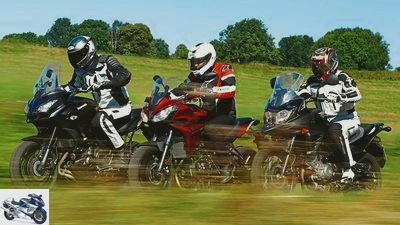
www.factstudio.de
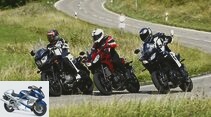
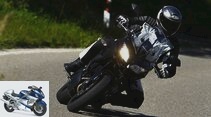
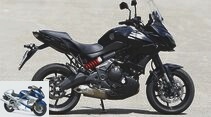

27 pictures

www.factstudio.de
1/27
Crossover comparison test with the Kawasaki Versys 650, Suzuki V-Strom 650 and Yamaha Tracer 700.
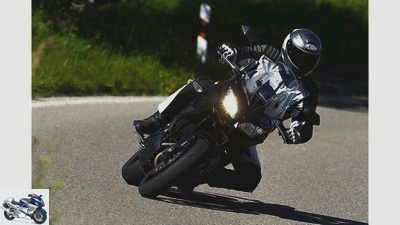
www.factstudio.de
2/27
Kawasaki Versys 650.
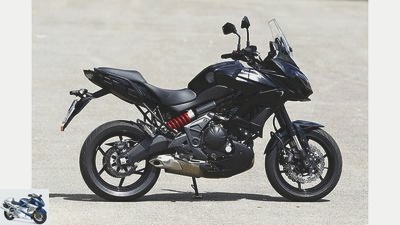
www.factstudio.de
3/27
Kawasaki Versys 650.

www.factstudio.de
4/27
Kawasaki Versys 650.
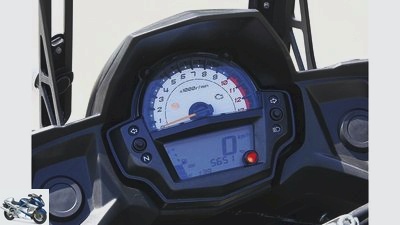
www.factstudio.de
5/27
The cockpit of the Versys 650 is small and divided into two parts, a gear indicator is missing.
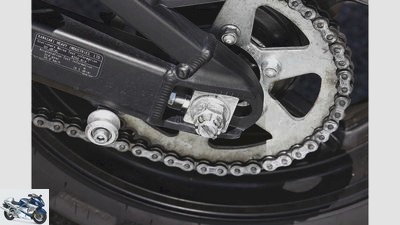
www.factstudio.de
6/27
Whether Kawasaki will ever run out of split pins securing the axle nut?
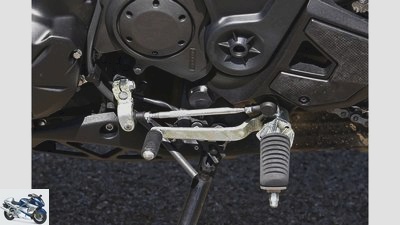
www.factstudio.de
7/27
Practical: The mountings on the swing arm for a rear wheel stand. The levers for operating the transmission are a bit clumsy and very functional.
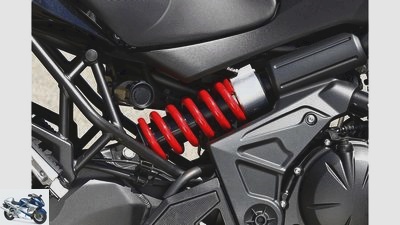
www.factstudio.de
8/27
The red pencil rules. On the other hand, it’s nice that the preload of the shock absorber can be easily changed using a practical handwheel.

www.factstudio.de
9/27
Comfortable, but high above the driver, it sits in the second row on the Versys.
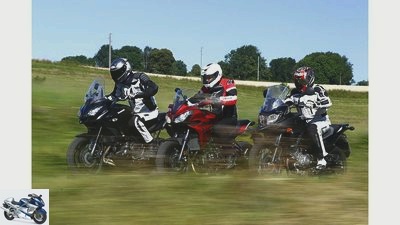
www.factstudio.de
10/27
Have fun without stress where the longest straight in the
Road layout never measures more than 500 meters.
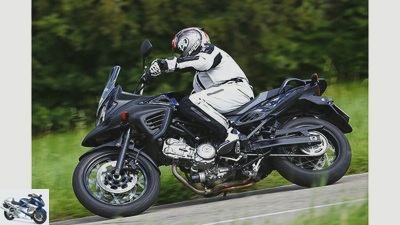
www.factstudio.de
11/27
Suzuki V-Strom 650.
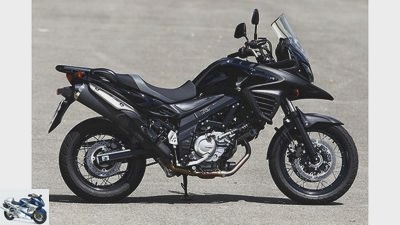
www.factstudio.de
12/27
Suzuki V-Strom 650.
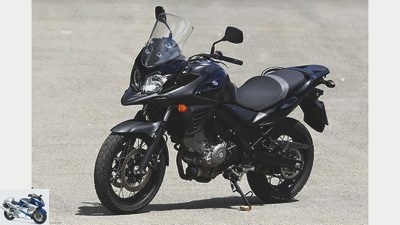
www.factstudio.de
13/27
Suzuki V-Strom 650.

www.factstudio.de
14/27
The tachometer dominates the cockpit of the V-Strom 650. The information on the display can be changed using a switch on the left end of the handlebar.
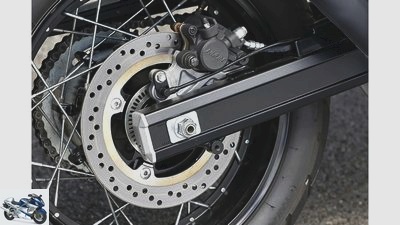
www.factstudio.de
15/27
Next to it: aluminum swing arm with simple chain tensioner.
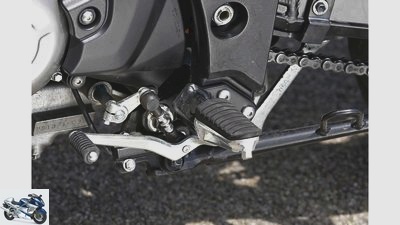
www.factstudio.de
16/27
It looks finer than the Kawasaki around the gearbox operation.
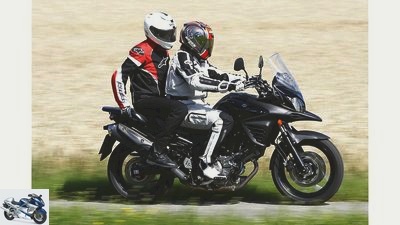
www.factstudio.de
17/27
Most of all, the space offered by the V-Strom flatters a passenger.
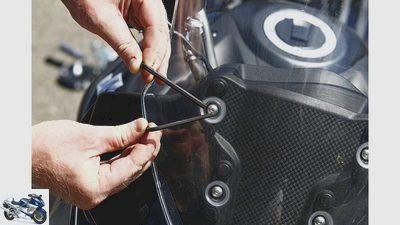
www.factstudio.de
18/27
The disc would have to be mounted in three positions – if, yes, if only the appropriate hexagon socket were also part of the on-board tool kit.
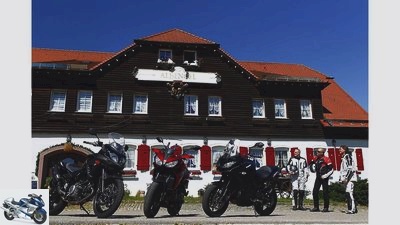
www.factstudio.de
19/27
Take a rest. On the three, thanks to the long range, this is more a wish than a compulsion.
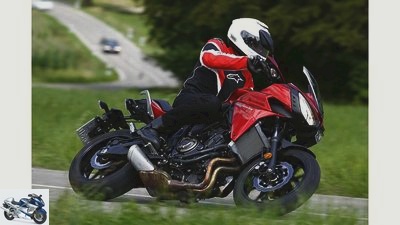
www.factstudio.de
20/27
Yamaha Tracer 700.
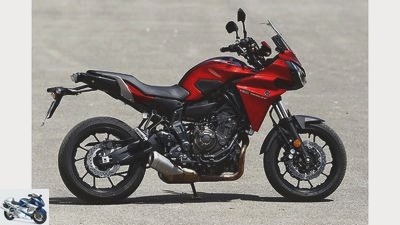
www.factstudio.de
21/27
Yamaha Tracer 700.
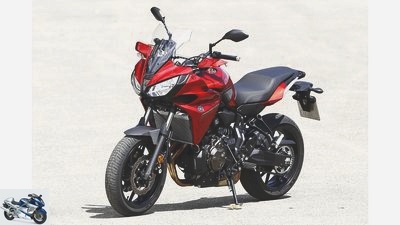
www.factstudio.de
22/27
Yamaha Tracer 700.
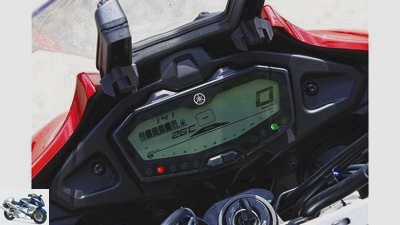
www.factstudio.de
23/27
The chain tensioner fixes the rear wheel axle.
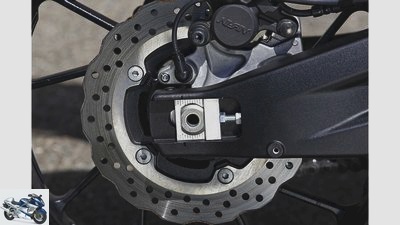
www.factstudio.de
24/27
The chain tensioner fixes the rear wheel axle.
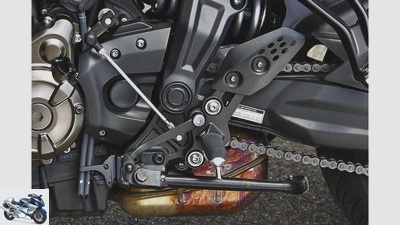
www.factstudio.de
25/27
When it comes to gear actuation, the Yamaha is the most handsome.
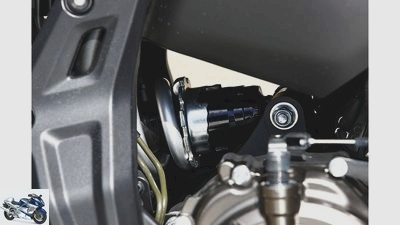
www.factstudio.de
26/27
In return, savings were made on the shock absorber. It is the only one that does not have a handwheel. It would not have been a bad thing to change the preload with the existing installation space.

www.factstudio.de
27/27
As a pillion passenger, you don’t travel too long on the Tracer because space is limited, especially to the rear.
motorcycles
Comparison test Kawasaki Versys 650, Suzuki V-Strom 650 and Yamaha Tracer 700
Kawasaki Versys 650, Suzuki V-Strom 650 and Yamaha Tracer 700
Crossover bikes in a comparison test
Fast around bends, comfortable when traveling, a reliable partner in everyday life: these are the characteristics that the three crossover bikes Kawasaki Versys 650, Suzuki V-Strom 650 and the new Yamaha Tracer 700 want to bring under one roof. The comparison test clarifies whether and how they succeed.
Jens Moller-Tollner
09/01/2016
The phone rings. The buddies want to use the sun-drenched day to ride a motorcycle extensively. But not only the small sporty round, but the big tour is on the agenda. How good that the MOTORRAD underground car park has the right bikes ready for you. The following are available for the exit: Kawasaki Versys 650, Suzuki V-Strom 650 and the new Yamaha Tracer 700. Shortly after the first cock’s crow it starts early in the morning. There are no curves right in front of the front door, so take the fastest route to the motorway and hurry to where motorcycling is really fun.
Buy complete article
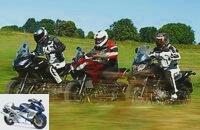
Kawasaki Versys 650, Suzuki V-Strom 650 and Yamaha Tracer 700
Crossover bikes in a comparison test
14 pages) as PDF
€ 2.00
Buy now
The Kawasaki Versys 650 takes the driveway with verve. The sixth gear is quickly in the somewhat bony gearbox despite the poor clutch metering. The tachometer needle rushes towards the red area. Close behind is the Suzuki V-Strom 650, where – as with the Yamaha Tracer 700 – Gear changes and clutch actuation succeed more smoothly. The Versys should pack 185 kilometers per hour, the same speed is promised for the Suzuki. And that’s true too. Both don’t give each other much, fly in pairs over the autobahn. Only the tracer settles, reaches a top speed of 200 km / h. Much more impressive, however, is how your engine dashes through the upper rev range when overtaking. If the Versys 650 and V-Strom 650 do the pull-through sprint from 140 to 180 km / h in the double-digit second range, they can handle it Tracer 700 this task is faster with 8.5 seconds.
Suzuki V-Strom 650 delivers the best wind protection
In order to make rapid progress in the long term, not only power is crucial, but also wind protection. All have height-adjustable discs. On the Suzuki V-Strom 650, the windshield can be changed in three stages. But only with tools. The hexagon socket required for this is missing in the on-board tool kit. Raising the shields is easier Yamaha Tracer 700 and Kawasaki Versys 650. Screw connections that are easy to operate by hand make things pleasant.
Still, the Suzuki V-Strom 650 does the best thing when it comes to wind protection. Even in the middle position, the wind scurries almost completely past the driver. This is due to the well-designed tear-off edge of the V-Strom disc. This version is missing from Yamaha and Kawasaki. The rider feels relatively well protected on the Kawasaki Versys 650, while the Yamaha Tracer 700 has the least protection from the oncoming hurricane.
It’s time to get off the freeway
The three of them are pretty impeccable when walking straight ahead. In the case of wake turbulences from vehicles in front, the is most likely to have a tendency Kawasaki Versys 650 Too slight restlessness, the Yamaha Tracer 700 is even less critical, while the Suzuki V-Strom 650 simply runs stubbornly and steadily in a straight line. Hilly landscapes push themselves into the foreground on the horizon. It’s time to get off the freeway. The Tracer 700 whizzes nimbly through the first arcs and works itself in an inclined position. Handy, more manageable, Tracer 700 – this superlative literally suggests itself.
In relation to the MT-07 – from which it is largely derived – the arm length increased by five centimeters, but this does not have a noticeable effect on the ease of wagging around bends. At 1450 millimeters, the wheelbase is rather long, while a 65.2 degree steering head angle and only 90 millimeters of caster stand for jaggedness. In addition: With a full 196 kilograms, the Tracer 700 prohibits any approach of obesity. The 17-inch tires in the 120/70 and 180/55 formats do not change the lightness of the Yamaha Tracer 700. Kawasaki Versys 650 (120/70 ZR 17 and 160/60 ZR 17) and Suzuki V-Strom 650 (110/80 R 19 and 150/70 R 17) have narrower tires.
How is the motorcycle lying on the road??
In the moody swing from bend to bend and back, not only handiness plays an important role. It is also crucial: What does the driver feel, how is the motorcycle lying on the road. In short: the trust has to be right. The Yamaha masters this challenge with great precision and feedback. This is due to the well-chosen Michelin Pilot Road 4 tires and the longer suspension strut, which is harder than the MT-07. The naked sister has already gone through the bends in wobbly mode, the Yamaha Tracer 700 has abandoned this behavior. The rear cushioning in particular is tighter. This promotes stability, but is also at the expense of comfort, as the new set-up means that significantly more of the roadway reaches the pilot’s rear than the driver approves. The non-adjustable fork of the Yamaha still works on the soft side, but overall the little Tracer lies well on the road in tight bends as well as in fast, wide bends. Only more freedom from lean angles would be desirable. The long fearful nipples throw sparks early, then the side stand follows around to the left.
With a small margin of respect, the Kawasaki Versys 650 follows the Yamaha Tracer 700 in terms of handiness. At 65 degrees, its steering head angle is almost as steep as that of the Yamaha, with a wheelbase of 1415 millimeters, it even has the shortest distance of the trio when it comes to the dimension between the two wheel axles. During the after-run, she turns the tables again. 108 millimeters is a lot and means stability. The bottom line is that the Versys 650 still circles around casually, but not quite as lightly through bends.
Kawasaki Versys 650 the heaviest
In addition, there is no feedback on large lean angles or when cornering quickly. Your upside-down fork looks great, but is softly tuned. The damper mounted directly between the swing arm and the frame, on the other hand, has a hard spring with only a little negative spring travel, combined with soft damping. This setup of the spring elements leads to an indifferent steering behavior. After the preload on the fork was turned ten turns and the rebound stage was only opened by 1.5 turns, the handling improved, but it was not really neutral. With the Kawasaki Versys 650, the driver has to trust that the mounted Dunlop Sportmax D222 in special specification J provide enough grip. This is a shame as the Versys only scratches its pegs late.
And the Suzuki V-Strom 650? This drops a little further in the agility aspect. Although it has the narrowest tires, it also has the longest wheelbase (1560 millimeters). And length is known to run straight ahead and not quite as willing into curves. The flattest steering head angle (64 degrees) and a lag of 110 millimeters do the rest. In addition, the fully charged V-Strom weighs 216 kilograms more than the Yamaha Tracer 700, the Kawasaki Versys 650 packs another eight pounds on top and is the heaviest of the trio.
The Tracer 700’s crossplane engine puts you in a good mood
In the search for the big cornering luck, the Suzuki does passably, because it counteracts the loss in handling a lot of stability in an inclined position – as with straight-line stability. The Suzuki V-Strom 650 also comes up with good feedback and waves with neutrality through every bend, however narrow or wide, which is unparalleled in this trio. This is due to the tire formats and the successful coordination of the spring elements. They work very synchronously, finely ironing out scars in the tar carpet, without getting into couching at a brisk pace. And because it grinds with the notches later than the Yamaha Tracer 700, you can poke heartily through curves with it.
The crossplane two-cylinder of the Yamaha Tracer 700 spreads a lot of humor in this terrain, where no straight line is longer than 500 meters. Its 270 degree crank pin offset gives it the character of a V2. Regardless of whether it is down, in the middle or at the top, the drive knows no weakness and marches energetically through the speed range. It responds cleanly to every gas command, paired smooth running with powerful power output. The test bench attests to 75.1 HP at 8900 rpm, 68.4 Nm at 6600 rpm. The other two can’t come close to that. Kawasaki and Suzuki strive almost in parallel flight through the rev range – with minimal advantages for the Suzuki V-Strom 650. The swings up to 68.8 horsepower at 9000 tours and 61 Nm at 6600 rpm. The only correct V2 of the test also shines with cultivated manners, but is not as fiery as the tracer unit. The drive of the Kawasaki Versys 650 is rougher and a little more restrained. The classic counter-runner lands at the bottom of the competition with 67 hp at 7300 rpm and 60.7 Nm at 7300 rotations of the crankshaft. What matters more, however, is that he gets down to business with slowed-down foam, his verve when climbing the speed ladder is contemplative. When comparing the driving performance, it’s only enough for third place.
Which one is most comfortable to sit on??
The first 200 kilometers in the saddle of the three motorcycles are a thing of the past, which is the right moment to pause for a moment. The apple spritzer stands next to the coffee, a piece of cake balances the calorie balance. This gives time to take a closer look at the seating positions. These turn out to be very different and are not on paper. The facts reveal: The distances between the pegs, seat and handlebars do not differ dramatically between the three, but the seating position on each bike in the trio is different. This is due to the differently contoured benches. The cushion of the tracer rises sharply towards the rear, so the driver crouches close to the tank. As a result, the ergonomics on the Yamaha Tracer 700 appear very compact, front-wheel-oriented, almost a bit super-motor-like.
The pilot sits on top of it with a sporty focus, eagerly awaiting the next bend in the road. This is almost a little too tight for tall people. This cannot be said of the Suzuki V-Strom 650. Your seat rises towards the tank, the Suzuki driver automatically slides a little further back on the wide and long bench. This results in a very comfortable posture that emphasizes the touring factor much more than the sport factor. And the Kawasaki Versys 650? It lies exactly in the middle between the two, offers enough space to slide back and forth with its straight upholstery, ideally combines the aspects of sport and touring. It looks similar in the second row. It’s tight on the Yamaha Tracer 700, with 171 kilograms the load limit is quickly reached. On the V-Strom (216 kilograms payload) it could be taken to the Mediterranean in one go. The Versys is positioned exactly between the two with its passenger space, and can even load the chassis with 220 kilograms.
How does it look in terms of fuel consumption?
The coffee cups are empty, the cake has been consumed, the engines hum again. A tight hairpin is pressed into the visor. The four-piston fixed calipers of the Yamaha grip with clean dosing. Shit, the curve is tighter than expected. The grip on the brake lever becomes harder in an instant. The fork sags a lot, the rear wheel comes up during the exploratory, spontaneous build-up of brake pressure without the ABS opening the brakes. Although all three have anti-lock braking systems, these do not have any lift detection for the rear wheel. If you hack the brakes on the Yamaha Tracer 700, you have to master a front wheel dance time and time again. An effect that increases when the vehicle is loaded. The Kawasaki Versys 650 behaves more good-natured under the same conditions, the Suzuki V-Strom 650 this tendency is completely alien. The following applies to the Yamaha: a better ABS control behavior, combined with a tighter fork, would help, because otherwise the stoppers of the tracers are convincing across the board. The Versys brake works flawlessly, but is not quite on the level of its Yamaha counterparts in terms of braking effect and dosage. The braking performance of the Suzuki is much more cautious. Even in the furthest position, the brake lever can be pulled up to the handlebar while standing. With a modest effect, this dilutes the dosability.
400 kilometers are behind us, the Yamaha is slowly wanting fresh fuel. The three consume it in pleasantly low doses. The Yamaha Tracer 700 sends 3.7 liters through its injection nozzles over 100 kilometers, 3.9 with the Suzuki V-Strom 650 and 4.0 with the Kawasaki Versys 650. The latter get a little further than the Yamaha, despite their slightly higher consumption, because they bunker more gasoline in the tank. If you exhaust it, you don’t have to go to the next petrol pump with them until after 500 kilometers. Just as little as with consumption separates Kawasaki, Suzuki and Yamaha in terms of price. The Versys 650 and Tracer 700 cost 7895 euros, the V-Strom 650 is five euros cheaper. In this trio, it is clearly the most travel-friendly. She anchored tours more than sport in the specifications. The Tracer 700 sees it the other way around, wants to pedal more quickly than to travel far and wide with pleasure. The Versys 650 stands between the two. She likes sport and is also a good partner for longer trips. And because the three of them master the topic of everyday life anyway, the question of personal favorites is more a question of whether your own mind likes it sporty or touristy.
Technical specifications
Here you can see an extract of the technical data. If you would like the complete measured values determined by us, including all consumption, torque and acceleration values, you can buy the article as a PDF for download.
MOTORCYCLE scoring
If you would like the detailed MOTORCYCLE score, you can purchase the article as a PDF for download.
Maximum
score Kawasaki
Versys 650 Suzuki
V-Strom 650 Yamaha
Tracer 700 Engine 250 129 137 157 Chassis 250 162 174 167 Everyday life 250 166 171 162 Safety 150 95 96 98 Costs 100 67 77 71 Overall rating 1000 619 655 655 placement 3. 1. 1. Price-performance grade top grade 1.0 1.5 1.0 1.0
MOTORCYCLE test result
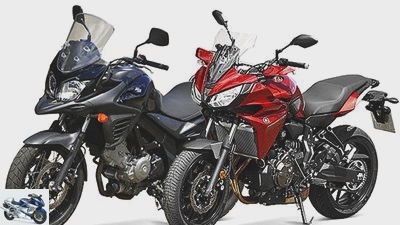
www.factstudio.de
Both landed in first place: Yamaha Tracer 700 and Suzuki V-Strom 650.
1. Yamaha Tracer 700
The Yamaha Tracer 700 makes the march, rushes to the top. She owes this primarily to her drive. In the remaining criteria, it still leaves room for improvement, which is why in the end it is only enough for a point patter with the Suzuki V-Strom 650.
2. Suzuki V-Strom 650
Oldie but Goldie: The Suzuki V-Strom 650 once again reveals its degree of maturity, impresses with its balance and shows no weaknesses. This concept is still good for victories twelve years after the first serve.
3. Kawasaki Versys 650
The Kawasaki Versys 650 is not a bad motorcycle. Only: Yamaha Tracer 700 and Suzuki V-Strom 650 are better. A more balanced chassis, a little more liveliness and longer inspection intervals would help to shorten the distance to the front.
Price comparison of the three crossover bikes
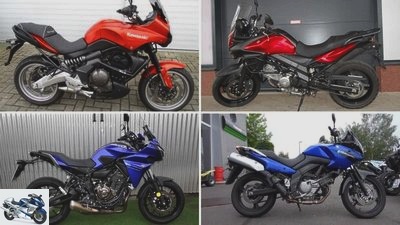
Used crossover bikes in Germany
Kawasaki Versys 650, Suzuki V-Strom 650 and Yamaha Tracer 700 face each other on the used motorcycle exchange in a direct price comparison. It is definitely worth a look, because all three are available in good condition and at reasonable prices: Used crossover bikes in Germany
Related articles
-
Comparison test MV Agusta Turismo Veloce 800 and Yamaha MT-09 Tracer
Bilski 19th pictures MOTORCYCLE 1/19 Power on the crankshaft. Measurements on the Dynojet roller test stand 250, corrected according to 95/1 / EG,…
-
Comparison test: Honda Hornet, Kawasaki Z 750, Suzuki GSR 600
Jahn motorcycles Comparison test: Honda Hornet, Kawasaki Z 750, Suzuki GSR 600 Comparison test: Honda Hornet, Kawasaki Z 750, Suzuki GSR 600 ABS shooters…
-
Comparison test between Suzuki DL 1000 V-Strom and Yamaha TDM 900
Artist motorcycles Comparison test between Suzuki DL 1000 V-Strom and Yamaha TDM 900 Comparison test between Suzuki DL 1000 V-Strom and Yamaha TDM 900…
-
Comparison test: Honda CBF 1000 Silverline, Suzuki Bandit 1250 S, Yamaha FZ1 Fazer
Jahn 22nd pictures Honda 1/22 Honda CBF 1000 Honda 2/22 Honda CBF 1000 Zdrahal 3/22 Presentation at the fair in Paris. Honda 4/22 Honda CBF 1000 Honda…
-
Middle class bikes from Yamaha, Kawasaki, Suzuki and Honda
fact 27 pictures fact 1/27 Comparison of mid-range motorcycles from Yamaha XJ6 Diversion F, Kawasaki ER-6f, Suzuki GSX 650 F and Honda CBF 600 S. fact…
-
Comparison test Ducati Monster 1200 S, Honda Fireblade, Kawasaki Z 1000 SX, Suzuki GSX-S 1000 F
jkuenstle.de 27 pictures jkuenstle.de 1/27 The disguised Suzuki GSX-S 1000 F has to prove itself in the field of competitors. jkuenstle.de 2/27 Nice is…
-
Mid-range crossover bikes in a comparison test
www.factstudio.de 32 pictures www.factstudio.de 1/32 Pepped up: The Honda NC 750 X was the only bike in the test field to be revised for this year……
-
BMW F 700 GS and Suzuki V-Strom 650 XT in comparison test
bilski-fotografie.de motorcycles BMW F 700 GS and Suzuki V-Strom 650 XT in comparison test BMW F 700 GS and Suzuki V-Strom 650 XT in comparison test…
-
fact motorcycles Top test Kawasaki Versys ABS Top test Kawasaki Versys ABS Quo Versys No tourer, no enduro, neither fun nor naked bike. Somehow the…
-
Concept comparison: Honda Fireblade, KTM 990 Super Duke R, Suzuki GSX-R 600, Yamaha FZ6
Gargolov motorcycles Concept comparison: Honda Fireblade, KTM 990 Super Duke R, Suzuki GSX-R 600, Yamaha FZ6 Concept comparison: Honda Fireblade, KTM 990…